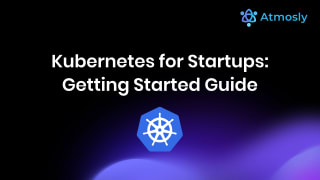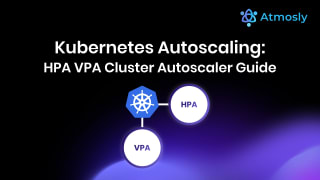Managing Kubernetes clusters at scale has always been one of the biggest challenges for DevOps teams on AWS. From provisioning nodes and configuring add-ons to managing upgrades and ensuring cost efficiency, manual cluster maintenance often slows innovation. That’s where Amazon EKS Auto Mode changes the game.
EKS Auto Mode introduces a new level of automation to Kubernetes management, handling compute, networking, and storage, so teams can focus on deploying and scaling applications, not managing infrastructure. It brings together the flexibility of Kubernetes with the simplicity of a managed cloud experience.
In this guide, we’ll explore what EKS Auto Mode is, how it differs from EKS Fargate, its pricing model, and why it’s a breakthrough for cloud-native operations. Plus, you’ll see how Atmosly builds on EKS Auto Mode to deliver even smarter automation, enhanced security, and complete visibility making Kubernetes management effortless from Day 0.
What is EKS Auto Mode?
EKS Auto Mode automates many of the management tasks associated with running Kubernetes clusters. It simplifies the deployment process by managing core components like compute instances, networking, and storage. This innovation is particularly beneficial for users who want to leverage Kubernetes best practices without getting bogged down by the intricacies of Kubernetes cluster management.
How EKS Auto Mode Works
At its core, EKS Auto operates by managing the control plane and worker nodes on behalf of the user. Previously, users had to manage their own worker nodes, including upgrading AMIs and installing necessary add-ons. With EKS Auto, AWS takes on this responsibility, allowing users to focus solely on running their applications.
Core Components Managed by EKS Auto
When you deploy a cluster using EKS Auto, AWS automatically manages several key components:
- Core Add-ons: Essential add-ons like Karpenter for autoscaling, Ingress controllers, and storage drivers are managed directly by AWS.
- Managed Instances: The worker nodes, now referred to as managed instances, are automatically provisioned and maintained, eliminating the need for manual intervention.
- Performance Optimization: EKS Auto constantly monitors the cluster's performance and optimizes resource allocation to ensure cost efficiency.
Why Do We Need EKS Auto?
The introduction of EKS Auto addresses several challenges faced by Kubernetes users:
- Reducing Operational Overhead: Users often find themselves overwhelmed by the management tasks associated with Kubernetes. EKS Auto reduces this burden significantly.
- Improving Scalability and Cost Efficiency: With AWS managing the infrastructure, users can be assured of high availability and scalability without having to configure complex settings.
- Cost Efficiency: EKS Auto optimizes resource usage, enabling better cost management than traditional setups.
EKS Auto Mode vs. EKS Fargate — Key Differences:
While EKS Auto and EKS Fargate may seem similar at first glance, there are significant differences that set them apart. Understanding these distinctions can help users choose the right solution for their needs.
1. Management of Core Add-ons
One of the primary differences is that EKS Auto manages core add-ons as part of the control plane. In contrast, with EKS Fargate, users must manage these add-ons themselves, which can complicate operations.
2. Worker Node Management
In EKS Auto, AWS takes care of the worker nodes, referred to as managed instances. This means users do not need to worry about AMIs or node groups. Conversely, EKS Fargate operates on a different model where each Fargate instance runs a single pod, which can limit flexibility and scalability.
3. Resource Allocation and Optimization
EKS Auto continuously monitors and optimizes resource allocation, automatically resizing EC2 instances in response to workload demand. In contrast, EKS Fargate does not offer this level of automated resource management, which can lead to inefficiencies.
4. Support for DaemonSets and Custom Workloads
With EKS Auto, users can run DaemonSets and customize their instances more freely compared to EKS Fargate, which has limitations on certain configurations. This flexibility enables a broader range of use cases and applications.
EKS Auto Mode vs. EKS Fargate – Feature Comparison
%201asd.png)
Benefits of Using EKS Auto Mode
Adopting EKS Auto Mode comes with a myriad of benefits that enhance the overall Kubernetes experience:
- Reduced Overhead and Better Cost Management: AWS handles day-to-day management, allowing teams to focus on development and innovation.
- Cost Efficiency: By dynamically scaling resources based on actual demand, EKS Auto minimizes costs without compromising performance.
- Improved Security: Automated patching and updates enhance your cluster's security posture of your cluster, ensuring it stays up to date with the latest security fixes.
- High Availability: EKS Auto leverages multiple Availability Zones (AZs) to ensure workload resilience and uptime.
By streamlining Kubernetes infrastructure management, EKS Auto enables teams to follow |cloud-native DevOps best practices, improving deployment speed and operational efficiency.
Upgrading with EKS Auto
Upgrading your EKS cluster is a straightforward process with EKS Auto. AWS intelligently manages upgrades of both the control plane and managed add-ons. This means that when a new version of Kubernetes or its components is released, AWS will handle the upgrade process, ensuring compatibility and stability.
For example, if a new version of the Ingress controller is available, EKS Auto will upgrade it while leaving other components unchanged if they do not require an update. This selective upgrading helps reduce the risk of disruption and ensures that your applications remain stable.
How to Get Started with EKS Auto Mode
To start using EKS Auto, follow these steps:
- Access the EKS Console: Go to the Amazon EKS console.
- Create a Cluster: Select the option to create a new cluster and enable EKS Auto Mode in the configuration settings.
- Configure Your Cluster: Set the cluster name, IAM roles, and other required configurations.
- Launch Your Cluster: Once set up, launch your cluster, and AWS will automatically manage the worker nodes and core components.
Ready to simplify kubernetes even more?
Try Atmosly and take the guesswork outof EKS management with automated scaling , security policies and cost optimization out of the box. Start Free Trials | Contant Us
Pricing Considerations for EKS Auto Mode
While EKS Auto Mode reduces operational complexity, understanding the pricing model is essential for budgeting and making informed architectural decisions.
Here’s how pricing breaks down for EKS Auto Mode:
1. EKS Cluster Control Plane
- Cost: $0.10 per hour per EKS cluster
- Includes: A highly available, managed control plane across multiple Availability Zones.
- Note: This charge applies to all EKS clusters, including those using Auto Mode or Fargate.
2. Managed Compute (Worker Nodes)
EKS Auto Mode uses Amazon EC2 instances behind the scenes for managed worker nodes. You are billed for the EC2 instances AWS provisions on your behalf.
- Cost Depends On:
- Instance types selected by EKS Auto Mode (e.g., t3.medium, m5.large)
- The number of nodes in use
- Uptime (per-second billing)
- EKS Auto scales instances dynamically, so costs fluctuate with workload demand.
- Savings Tip: You can reduce costs using Savings Plans or Spot Instances (if supported by your workload).
3. Add-ons and Storage
- EBS Volumes (if used): Charged per GB-month and per IOPS, based on the type of volume (e.g., gp3, io2).
- Managed Add-ons: AWS provides and updates core add-ons like Karpenter, CoreDNS, and VPC CNI as part of the service. Some add-ons are free; others may incur charges (e.g., using enhanced observability tools).
How Atmosly Enhances EKS Management Beyond EKS Auto Mode
While EKS Auto Mode offers a significant leap in simplifying Kubernetes management, Atmosly takes this a step further by providing even more flexibility, control, and efficiency in managing EKS clusters.
Here's how Atmosly enhances EKS management compared to EKS Auto Mode:
1. Advanced Customization and Flexibility
EKS Auto Mode emphasizes automation and simplicity but comes with certain customization limits. In contrast, with this solution, you gain enhanced control over your EKS environment:
- Custom AMIs and Node Configurations: Unlike EKS Auto Mode, it allows you to use custom Amazon Machine Images (AMIs) and tailor node configurations to meet specific application needs.
- Support for Complex Workloads: Fine-grained configurations enable the management of advanced networking, security, and custom Kubernetes resources without constraints.
2. Seamless Upgrade Management
Automated systems like EKS Auto Mode can make upgrade management challenging. This platform offers:
- Controlled Upgrades: Strategies to selectively update control planes and node groups ensure stability and compatibility instead of blanket upgrades.
- Minimized Downtime: The upgrade process is designed to reduce disruption, keeping your applications available and performant during updates.
3. Enhanced Security and Compliance
Security is foundational in Kubernetes management. This tool enhances:
- Custom Security Policies: Implement organization-specific security rules, role-based access controls, and compliance frameworks tailored to your business.
4. Greater Flexibility in Resource Management
EKS Auto Mode automates resource allocation but may lead to overprovisioning. This alternative provides:
- Dynamic Resource Optimization: Continuous analysis of resource usage helps maintain performance and cost-efficiency.
- Support for DaemonSets and Stateful Workloads: Flexible management enables running workloads that require persistent storage or complex deployments.
5. Efficient Cost Management
Cost control is crucial for Kubernetes workloads:
- Automated Cost Insights: Advanced monitoring and analytics provide a clear view of cluster expenses.
- Intelligent Scaling: Enhanced scaling complements AWS's native tools, helping you minimize waste and stick to your budget.
6. Comprehensive Support and Guidance
This solution ensures you get the most out of your EKS clusters through:
- Migration Support: Tools and best practices simplify transitioning from other platforms.
- Detailed Documentation and Community Engagement: Access to practical guides, troubleshooting resources, and active support equips you to confidently handle both common and complex scenarios.
Conclusion: Simplify Kubernetes with Atmosly
Amazon EKS Auto Mode is a major leap forward for Kubernetes management, automating cluster operations, scaling, and add-on maintenance so teams can focus on innovation instead of infrastructure.
But for organizations seeking even greater control, cost efficiency, and flexibility, Atmosly takes it further. With features like intelligent scaling, custom security policies, and controlled upgrade management, Atmosly transforms how DevOps teams manage EKS cluster,s delivering speed, savings, and security at scale.
Try Atmosly today and simplify Kubernetes management beyond EKS Auto Mode no scripts, no manual tuning, just automation that works.
.png)





